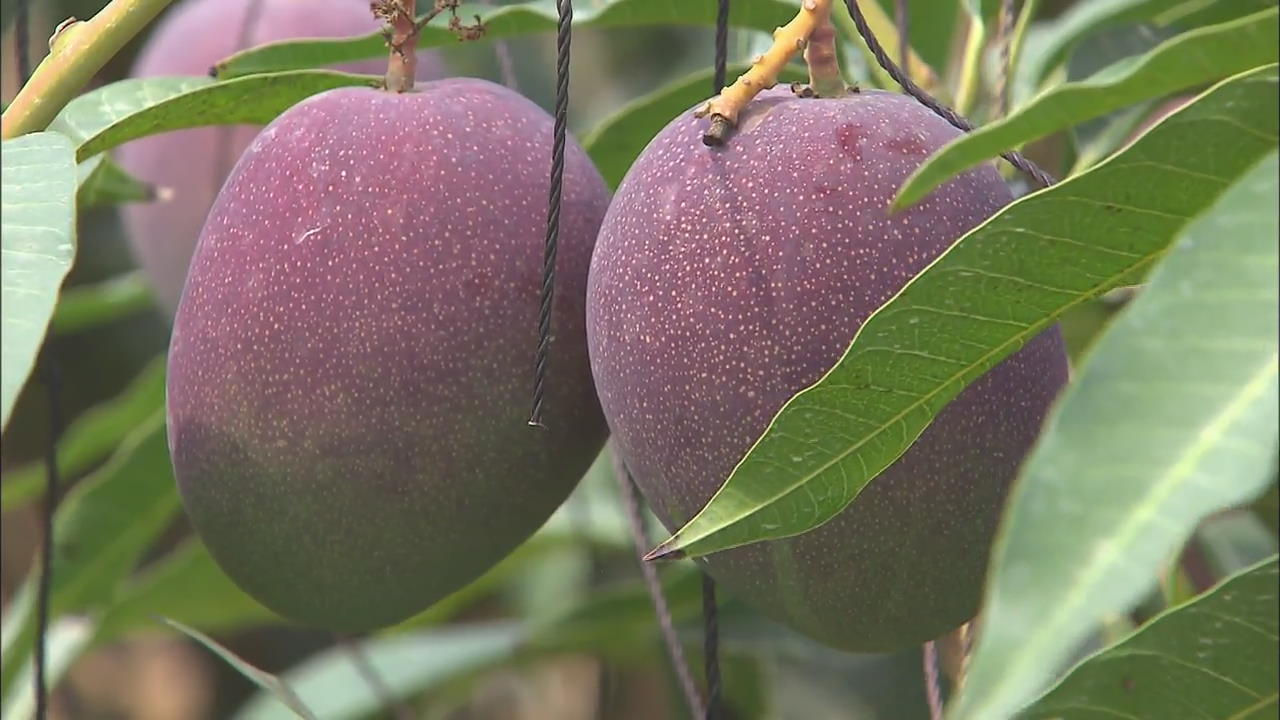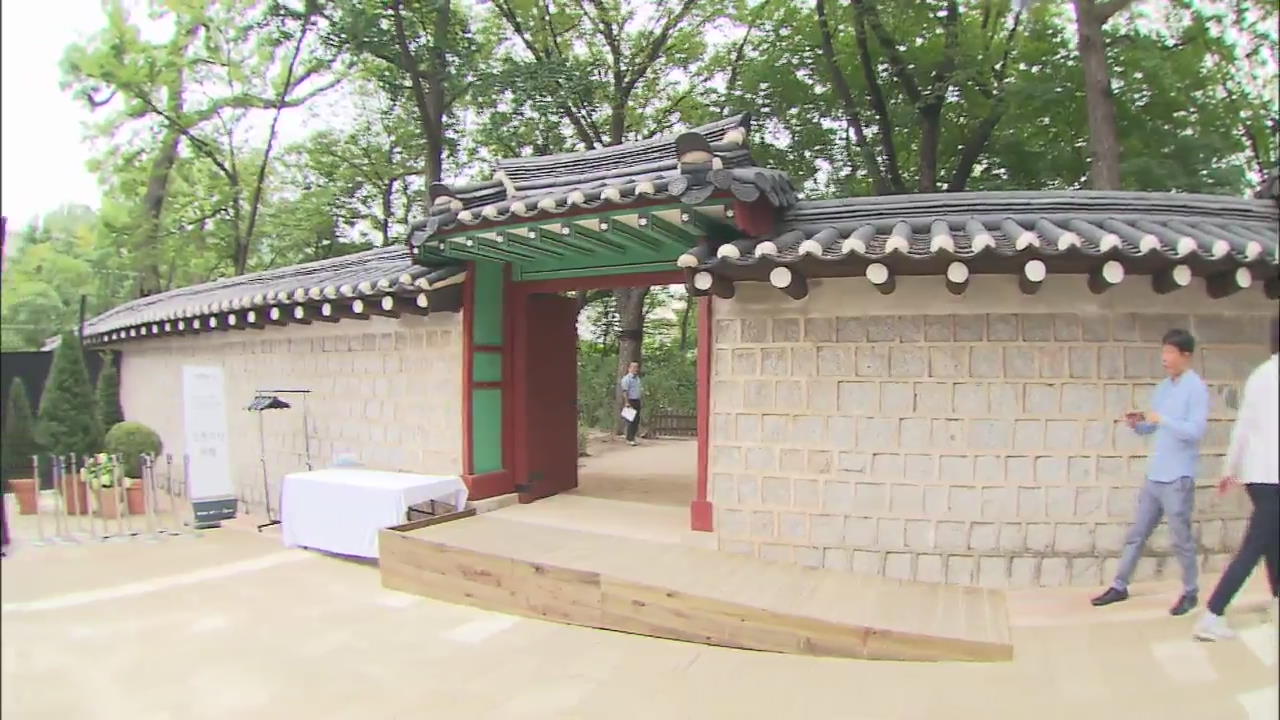Changing Agriculture
입력 2017.08.31 (14:09)
수정 2017.08.31 (14:20)
읽어주기 기능은 크롬기반의
브라우저에서만 사용하실 수 있습니다.
[Anchor Lead]
Sub-tropical crops are gradually taking firm root in Korea, which means that Korea's climate is becoming warmer. In our next report, we take you to regions of Korea where the agricultural landscape is changing along with the climate.
[Pkg]
This pork dish was made right on the spot by a professional chef. One of its ingredients is a Vietnamese vegetable called Morning Glory. This subtropical vegetable is grown these days in Korea's Chungcheong-do region. In addition to Morning Glory, this farm also specializes in bitter melons, which originated from India.
[Soundbite] (Farmer (lived in Korea for 10 years)) : "I grew cilantro at first, but my friends recommended that I try something else."
Subtropical fruits such as dragon fruit, passionfruit and guava are available at Korean supermarkets these days. The promising crops of the future selected by the Korean government include 20 species of subtropical fruits and vegetables. This is all the result of the warming climate on the Korean Peninsula.
[Soundbite] Hwang Jung-hwan(Director, Nat’l Institute of Horticultural & Herbal Science) : "In the next three years about 10 percent of farmland in Korea will become subtropical."
This farm on Jejudo Island had cultivated tangerines for 30 years before it decided to switch to papayas and bananas. The area of subtropical crops cultivated in Korea has expanded by a factor of 12 in just ten years. Yeongam in Jeollanam-do Province now specializes in figs, while dragon fruit is now the regional specialty of Jinju, Gyeongsangnam-do Province. And farmers in Paju, a city on the northernmost tip of South Korea, are harvesting their first apple mangoes these days. Meanwhile, concerns are rising that Korean indigenous crops may gradually lose ground because of the spread of subtropical crops caused by climate change.
Sub-tropical crops are gradually taking firm root in Korea, which means that Korea's climate is becoming warmer. In our next report, we take you to regions of Korea where the agricultural landscape is changing along with the climate.
[Pkg]
This pork dish was made right on the spot by a professional chef. One of its ingredients is a Vietnamese vegetable called Morning Glory. This subtropical vegetable is grown these days in Korea's Chungcheong-do region. In addition to Morning Glory, this farm also specializes in bitter melons, which originated from India.
[Soundbite] (Farmer (lived in Korea for 10 years)) : "I grew cilantro at first, but my friends recommended that I try something else."
Subtropical fruits such as dragon fruit, passionfruit and guava are available at Korean supermarkets these days. The promising crops of the future selected by the Korean government include 20 species of subtropical fruits and vegetables. This is all the result of the warming climate on the Korean Peninsula.
[Soundbite] Hwang Jung-hwan(Director, Nat’l Institute of Horticultural & Herbal Science) : "In the next three years about 10 percent of farmland in Korea will become subtropical."
This farm on Jejudo Island had cultivated tangerines for 30 years before it decided to switch to papayas and bananas. The area of subtropical crops cultivated in Korea has expanded by a factor of 12 in just ten years. Yeongam in Jeollanam-do Province now specializes in figs, while dragon fruit is now the regional specialty of Jinju, Gyeongsangnam-do Province. And farmers in Paju, a city on the northernmost tip of South Korea, are harvesting their first apple mangoes these days. Meanwhile, concerns are rising that Korean indigenous crops may gradually lose ground because of the spread of subtropical crops caused by climate change.
■ 제보하기
▷ 카카오톡 : 'KBS제보' 검색, 채널 추가
▷ 전화 : 02-781-1234, 4444
▷ 이메일 : kbs1234@kbs.co.kr
▷ 유튜브, 네이버, 카카오에서도 KBS뉴스를 구독해주세요!
- Changing Agriculture
-
- 입력 2017-08-31 14:04:42
- 수정2017-08-31 14:20:59

[Anchor Lead]
Sub-tropical crops are gradually taking firm root in Korea, which means that Korea's climate is becoming warmer. In our next report, we take you to regions of Korea where the agricultural landscape is changing along with the climate.
[Pkg]
This pork dish was made right on the spot by a professional chef. One of its ingredients is a Vietnamese vegetable called Morning Glory. This subtropical vegetable is grown these days in Korea's Chungcheong-do region. In addition to Morning Glory, this farm also specializes in bitter melons, which originated from India.
[Soundbite] (Farmer (lived in Korea for 10 years)) : "I grew cilantro at first, but my friends recommended that I try something else."
Subtropical fruits such as dragon fruit, passionfruit and guava are available at Korean supermarkets these days. The promising crops of the future selected by the Korean government include 20 species of subtropical fruits and vegetables. This is all the result of the warming climate on the Korean Peninsula.
[Soundbite] Hwang Jung-hwan(Director, Nat’l Institute of Horticultural & Herbal Science) : "In the next three years about 10 percent of farmland in Korea will become subtropical."
This farm on Jejudo Island had cultivated tangerines for 30 years before it decided to switch to papayas and bananas. The area of subtropical crops cultivated in Korea has expanded by a factor of 12 in just ten years. Yeongam in Jeollanam-do Province now specializes in figs, while dragon fruit is now the regional specialty of Jinju, Gyeongsangnam-do Province. And farmers in Paju, a city on the northernmost tip of South Korea, are harvesting their first apple mangoes these days. Meanwhile, concerns are rising that Korean indigenous crops may gradually lose ground because of the spread of subtropical crops caused by climate change.
Sub-tropical crops are gradually taking firm root in Korea, which means that Korea's climate is becoming warmer. In our next report, we take you to regions of Korea where the agricultural landscape is changing along with the climate.
[Pkg]
This pork dish was made right on the spot by a professional chef. One of its ingredients is a Vietnamese vegetable called Morning Glory. This subtropical vegetable is grown these days in Korea's Chungcheong-do region. In addition to Morning Glory, this farm also specializes in bitter melons, which originated from India.
[Soundbite] (Farmer (lived in Korea for 10 years)) : "I grew cilantro at first, but my friends recommended that I try something else."
Subtropical fruits such as dragon fruit, passionfruit and guava are available at Korean supermarkets these days. The promising crops of the future selected by the Korean government include 20 species of subtropical fruits and vegetables. This is all the result of the warming climate on the Korean Peninsula.
[Soundbite] Hwang Jung-hwan(Director, Nat’l Institute of Horticultural & Herbal Science) : "In the next three years about 10 percent of farmland in Korea will become subtropical."
This farm on Jejudo Island had cultivated tangerines for 30 years before it decided to switch to papayas and bananas. The area of subtropical crops cultivated in Korea has expanded by a factor of 12 in just ten years. Yeongam in Jeollanam-do Province now specializes in figs, while dragon fruit is now the regional specialty of Jinju, Gyeongsangnam-do Province. And farmers in Paju, a city on the northernmost tip of South Korea, are harvesting their first apple mangoes these days. Meanwhile, concerns are rising that Korean indigenous crops may gradually lose ground because of the spread of subtropical crops caused by climate change.
이 기사가 좋으셨다면
-
좋아요
0
-
응원해요
0
-
후속 원해요
0













![[영상] 무단침입에, 주행 중 <br>찰칵? 불꽃축제 이후…](/data/fckeditor/vod/2024/10/06/306961728217699214.jpg)



이 기사에 대한 의견을 남겨주세요.